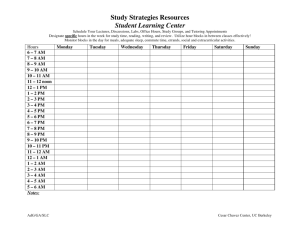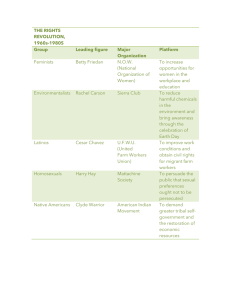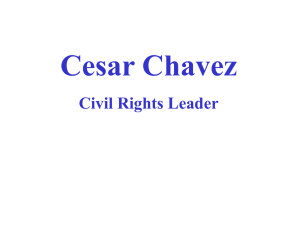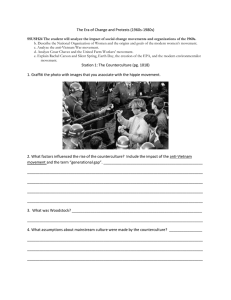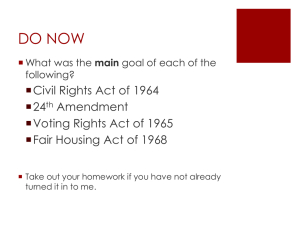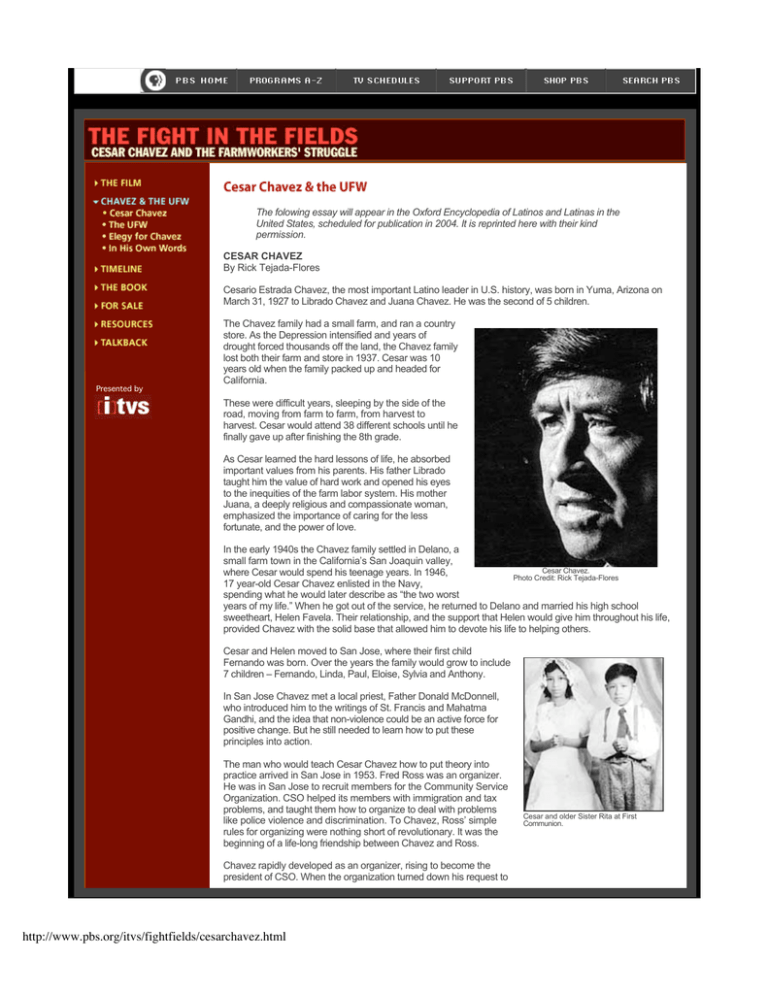
The folowing essay will appear in the Oxford Encyclopedia of Latinos and Latinas in the
United States, scheduled for publication in 2004. It is reprinted here with their kind
permission.
CESAR CHAVEZ
By Rick Tejada-Flores
Cesario Estrada Chavez, the most important Latino leader in U.S. history, was born in Yuma, Arizona on
March 31, 1927 to Librado Chavez and Juana Chavez. He was the second of 5 children.
Presented by
The Chavez family had a small farm, and ran a country
store. As the Depression intensified and years of
drought forced thousands off the land, the Chavez family
lost both their farm and store in 1937. Cesar was 10
years old when the family packed up and headed for
California.
These were difficult years, sleeping by the side of the
road, moving from farm to farm, from harvest to
harvest. Cesar would attend 38 different schools until he
finally gave up after finishing the 8th grade.
As Cesar learned the hard lessons of life, he absorbed
important values from his parents. His father Librado
taught him the value of hard work and opened his eyes
to the inequities of the farm labor system. His mother
Juana, a deeply religious and compassionate woman,
emphasized the importance of caring for the less
fortunate, and the power of love.
In the early 1940s the Chavez family settled in Delano, a
small farm town in the California’s San Joaquin valley,
Cesar Chavez.
where Cesar would spend his teenage years. In 1946,
Photo Credit: Rick Tejada-Flores
17 year-old Cesar Chavez enlisted in the Navy,
spending what he would later describe as “the two worst
years of my life.” When he got out of the service, he returned to Delano and married his high school
sweetheart, Helen Favela. Their relationship, and the support that Helen would give him throughout his life,
provided Chavez with the solid base that allowed him to devote his life to helping others.
Cesar and Helen moved to San Jose, where their first child
Fernando was born. Over the years the family would grow to include
7 children – Fernando, Linda, Paul, Eloise, Sylvia and Anthony.
In San Jose Chavez met a local priest, Father Donald McDonnell,
who introduced him to the writings of St. Francis and Mahatma
Gandhi, and the idea that non-violence could be an active force for
positive change. But he still needed to learn how to put these
principles into action.
The man who would teach Cesar Chavez how to put theory into
practice arrived in San Jose in 1953. Fred Ross was an organizer.
He was in San Jose to recruit members for the Community Service
Organization. CSO helped its members with immigration and tax
problems, and taught them how to organize to deal with problems
like police violence and discrimination. To Chavez, Ross’ simple
rules for organizing were nothing short of revolutionary. It was the
beginning of a life-long friendship between Chavez and Ross.
Chavez rapidly developed as an organizer, rising to become the
president of CSO. When the organization turned down his request to
http://www.pbs.org/itvs/fightfields/cesarchavez.html
Cesar and older Sister Rita at First
Communion.
organize farmworkers in 1962, he resigned and returned to Delano.
From 1962 to 1965 he crisscrossed the state, talking to farmworkers.
His new organization, the National Farmworkers Association
(NFWA), would use the model of community service that Cesar had
learned in CSO. Chavez didn’t want to call it a union, because of the
long history of failed attempts to create agricultural unions, and the
bitter memories of those who had been promised justice and then
abandoned.
In 1965, the union issue finally exploded. The Agricultural Workers
Organizing Committee (AWOC), a mostly Filipino union, struck
when the Delano grape growers cut the pay rates during the harvest.
Chavez asked his organization to join the strike, and quickly became
its leader.
The strikers faced odds that could not be overcome by traditional
labor tactics. Under Chavez’ leadership, the struggle became defined
in new terms. They would do battle non-violently, since they could
never match the growers in physical force. They were a poor
movement, so they would emphasize their poverty. For many years
every organizer and volunteer from Chavez down would be paid
room and board and $5 a week. Although there were picket lines in
the fields, the real focus moved to the cities where grapes were sold.
Hundreds of students, religious workers and labor activists talked to
consumers in front of markets, asking them to do a simple thing:
“Help the farmworkers by not buying grapes.” At its height, over 13
million Americans supported the Delano grape boycott.
Teenage Cesar, a friend and brother
Richard sport zoot zuit fashions.
The pressure was irresistable, and in 1969 the Delano growers
signed historic contracts with the United Farmworkers Organizing
Committee, which would later become the United Farmworkers
Union (UFW).
Chavez had inspired an organization that did not look like a labor
union. His vision didn’t include just the traditional bread and butter
Cesar in WWII Navy dress uniform.
issues of unionism; it was about reclaiming dignity for people who
were marginalized by society. What had started as the Delano grape
strike came to be known as La Causa, the Cause. Whether they were farmworkers fighting for a better life,
or middle class students trying to change the world, those who were drawn to the farmworkers movement
were inspired by Chavez’ example to put aside their normal lives and make exceptional sacrifices.
Chavez placed harsher demands on himself than on anyone else in the movement. In 1968 he fasted (the
first of several fasts over his lifetime), to recommit the movement to non-violence. In many ways the fast
epitomized Chavez’s approach to social change. On one level it represented his spiritual values, his
willingness to sacrifice and do penance. At the same time, he and his lieutenants were extremely aware of
the political ramifications of his actions, using the fast as a way of both publicizing and organizing for their
movement.
Fasting was just one expression of his deep spirituality. Like most farmworkers, Chavez was a devout
Catholic. His vision of religion was a progressive one, that prefigured the “preferential option for the poor”
of liberation theology. In the UFW, the mass was a call to action as well as a rededication of the spirit.
The 1968 fast marked the beginning of Chavez’ emergence on the
national political scene. Presidential candidate Robert Kennedy came
to Delano to break bread with Cesar at the end of his fast. Chavez
responded by committing UFWOC to campaign for Kennedy in the
California primary. Their voter registration and get out the vote
efforts provided Kennedy’s margin of victory in California.
Over the years the UFW would become a significant political force,
demonstrating that Mexican Americans could and would participate
in electoral politics when their concerns were at stake. Chavez’
understanding of the relationship between economic issues and
political participation was the starting point for a growing wave of
Latino activism and electoral activity, that would eventually lead to
the election of thousands of Latino officials and a major shift in the
American political landscape.
Chavez had never expected that victory in the battle for farmworkers’
rights would be achieved during his lifetime. In fact, the first stunning
victories in the grapes were followed by major setbacks. First in the
http://www.pbs.org/itvs/fightfields/cesarchavez.html
Cesar plays softball with his teenage son
Paul.
lettuce industry, and then when the grape contracts expired in 1972,
growers sought out the powerful Teamsters Union, and signed
contracts with them that rolled back the UFW's hard fought gains.
The UFW responded with strikes that led to the jailing of thousands.
Many strikers were injured by violent attacks on the picket lines, and
two were killed in dreveby shootings and attacks.. But the
“inter-union” battle had left the public confused and made a new
boycott against lettuce and grape growers difficult.
Chavez looked for a political solution to the impasse. He supported
Jerry Brown’s bid to become governor of California, and in return
was able to engineer the nation’s first law giving farmworkers the
right to union elections. The passage of the Agricultural Labor
Relations Act in 1975 led to an overwhelming series of UFW election
victories, and it seemed that Chavez had finally achieved his goal of
organizing farmworkers.
Helen and Cesar Chaves in the 1960's with
3 of their children.
The UFW had given up the boycott in exchange for the right to union
elections. But relying on the law became uncertain, as growers
learned to use it to delay signing contracts. After early successes
under the farm labor law, Chavez pulled back from organizing,
although he continued to travel extensively to promote awareness of
the farmworkers struggle. The election of a Republican governor in
1982 made enforcing the law even more difficult.
Chavez’ goals and vision were changing as well. He began to focus
on the dangers of pesticides, which had always been a major source A weary Cezar Chavez during a rare
moment of solitude.
of illness among farmworkers. It was a subject that drew a positive
response from an environmentally conscious public. Instead of using
volunteers, he relied more and more on direct mail. He built low-cost housing for farmworkers, and
considered starting an urban organizing campaign in Mexican-American communities. He became
interested in modern management techniques and group dynamics, including the group therapy techniques
of Synanon, a drug rehabilitation program.
Although questions were raised about his effectiveness in later years, Cesar Chavez
had become a remarkable symbol — for Latinos, community activists, the labor
movement, young people, and all who valued his values and commitment. He had
accomplished something that no one else had ever been able to do; build a union for
farmworkers. In the process he trained a generation of activists who would apply their
skills in other communities and struggles.
Cesar Chavez died in Yuma Arizona on April 23, 1993, near his birthplace in Yuma,
Arizon. He was 66 years old. His funeral in Delano attracted thousands of Americans from all walks of life.
Years before his death, Chavez was asked by a union member if he wanted to be remembered by statues
and public memorials. Chavez replied, “If you want to remember me, organize!”
The UFW | Cesar Chavez Elegy | His Own Words | Timeline
Home | The Film | Chavez & UFW | Timeline | The Book | For Sale | Resources | Talkback
© Copyright 2004. Paradigm Productions and Independent Television Service (ITVS). All Rights Reserved.
http://www.pbs.org/itvs/fightfields/cesarchavez.html

